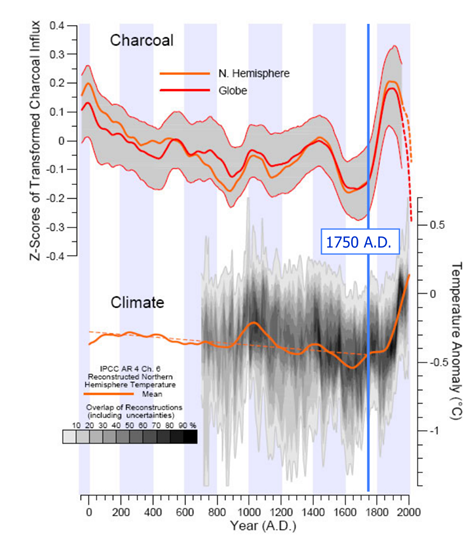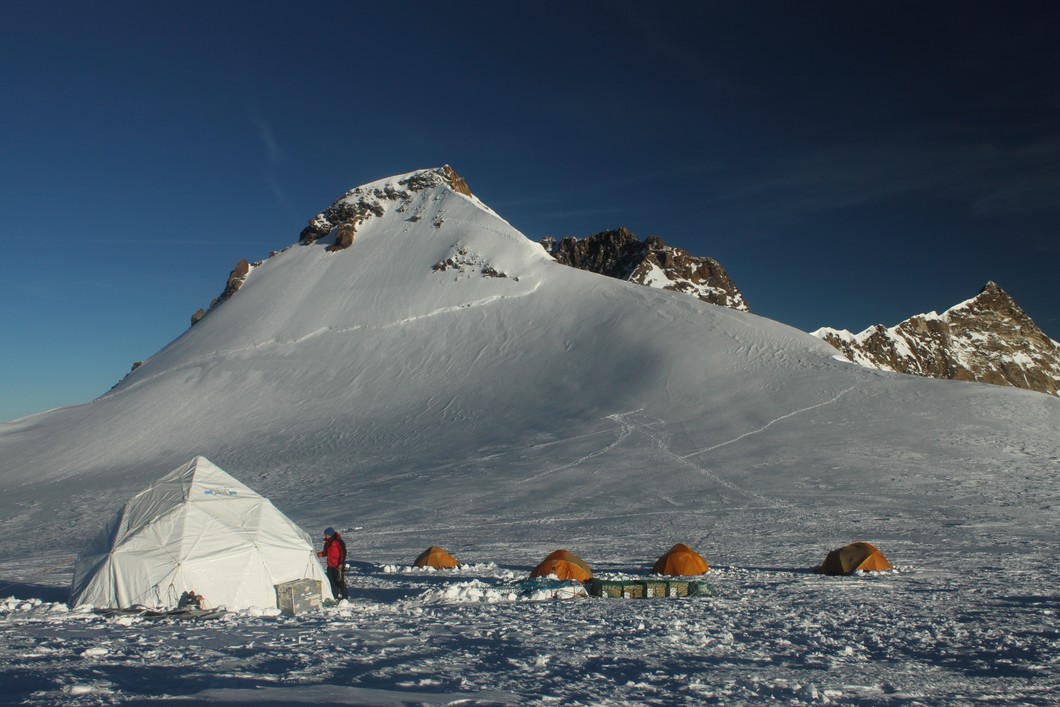Paleo Fires
Background
Fires play a major role in the global carbon budget through emissions of greenhouse gases and aerosols. On a global scale, today's biomass burning emissions contribute roughly 50% of those from fossil fuel combustion. However, the most important drivers for the long-term biomass burning trend are still largely debated. During the last 150 years, a decoupling of fire activity from the main drivers (temperature and population density) was suggested. Because of its typical shape, the reconstructed fire activity pattern was denominated "broken" fire hockey stick. The decoupling between fire and climate is in agreement with increases in landscape fragmentation, but is not supported by other data such as methane concentrations, implying that the underlying processes are not fully understood. This lack of understanding in combination with the worldwide occurrence of devastating wildfires in the past decades raises major concerns about the capacity to manage fire under future climate change scenarios.
Scope of the project
The project "Paleo fires from high-alpine ice cores" (further referred to as Paleo fires) is an integrated research frame work aiming to test the hypothesis of the "broken" fire hockey stick. The overall objective is to significantly advance the understanding of complex systemic linkages between climate, land use, fire and vegetation for different regions over the most recent period of the last 150 years in comparison to the previous 2000 years.
The approach of Paleo fires is to establish regional paleo fire histories from multi-proxy high-alpine ice core records in the four geographical areas of Central Europe (Colle Gnifetti, Swiss Alps), Southern Siberia (Belukha and Tsambagarav, respectively Russia and Mongolia), tropical Amazonia (Illimani, Bolivia), and the Arctic (Lomonosovfonna, Svalbard), using Black Carbon (BC) and charcoal as fire tracers. The atmospheric footprint of the ice cores in terms of the different sources contributing to BC and charcoal will be determined using back trajectories and global modelling of biomass burning relevant tracers to better understand the representativeness of the individual proxies. Quantitative transfer functions will be developed through identification of single fire events and their corresponding burned area from satellite data in combination with air mass trajectories.
Paleo fires is based on analyses of existing high-alpine ice cores with a good, controlled chronology particularly for the time period AD1850 to present, allowing linking modern ice core data directly with coinciding observations from satellites. This is a major advantage compared to previous fire records, which are partly undated and usually have multi-decadal resolutions only. The ice cores have the additional benefit of containing complementary information on past climate and vegetation changes on the same high-resolution time scale as the fire tracers.
To our knowledge, Paleo fires is the first interdisciplinary project aiming at reconstructing fire history from ice core data. It involves four different research groups (analytical chemistry, paleoecology, atmospheric modeling, remote sensing) coming from different Swiss research institutes (Paul Scherrer Institut, University of Bern, ETH Zürich).
The approach of Paleo fires is to establish regional paleo fire histories from multi-proxy high-alpine ice core records in the four geographical areas of Central Europe (Colle Gnifetti, Swiss Alps), Southern Siberia (Belukha and Tsambagarav, respectively Russia and Mongolia), tropical Amazonia (Illimani, Bolivia), and the Arctic (Lomonosovfonna, Svalbard), using Black Carbon (BC) and charcoal as fire tracers. The atmospheric footprint of the ice cores in terms of the different sources contributing to BC and charcoal will be determined using back trajectories and global modelling of biomass burning relevant tracers to better understand the representativeness of the individual proxies. Quantitative transfer functions will be developed through identification of single fire events and their corresponding burned area from satellite data in combination with air mass trajectories.
Paleo fires is based on analyses of existing high-alpine ice cores with a good, controlled chronology particularly for the time period AD1850 to present, allowing linking modern ice core data directly with coinciding observations from satellites. This is a major advantage compared to previous fire records, which are partly undated and usually have multi-decadal resolutions only. The ice cores have the additional benefit of containing complementary information on past climate and vegetation changes on the same high-resolution time scale as the fire tracers.
To our knowledge, Paleo fires is the first interdisciplinary project aiming at reconstructing fire history from ice core data. It involves four different research groups (analytical chemistry, paleoecology, atmospheric modeling, remote sensing) coming from different Swiss research institutes (Paul Scherrer Institut, University of Bern, ETH Zürich).
Field campaigns
- Shallow ice core from Illimani (6300 m a.s.l.), Bolivia, June 2015.
- 2 deep ice cores from Colle Gnifetti (4450 m a.s.l.), Swiss Alps, September 2015.
- Snowpit sampling, Jungfraujoch, Swiss Alps, June 2017.
- 2 deep ice cores from Belukha, Siberian Altai (4050 m a.s.l.), Russia, June 2018.
Funding
Swiss National Science Foundation (SNF), Sinergia programme, grant number 154450.
People involved
- Subgroup A: Analytical Chemistry Group, Laboratory of Environmental Chemistry, Paul Scherrer Institut, Villigen.
- Margit Schwikowski (PI)
- Michael Sigl
- Dimitri Osmont (PhD)
- Subgroup B: Paleoecology section, Institute of Plant Sciences, University of Bern.
- Willy Tinner (Co-PI)
- Daniele Colombaroli
- Erika Gobet
- Sandra Brügger (PhD)
- Subgroup C: Institute for Atmospheric and Climate Science, ETH Zürich.
- Ulrike Lohmann (Co-PI)
- Isabelle Bey
- Luisa Ickes
- Anina Gilgen (PhD)
- Subgroup D: Remote Sensing Research Group, Institute of Geography, University of Bern.
- Stefan Wunderle (Co-PI)
- Christoph Neuhaus
- Helga Weber (PhD)
Publications
- Brugger, S.O., Gobet, E., Schanz, F. R., Heiri, O., Schwörer, C., Sigl, M., Schwikowski, M., and Tinner, W.: A quantitative comparison of microfossil extraction methods from ice cores, Journal of Glaciology, 64(245), 432–442, 2018, https://doi.org/10.1017/jog.2018.31.
- Brugger, S. O., Gobet, E., Sigl, M., Osmont, D., Papina, T., Rudaya, N., Schwikowski, M., and Tinner, W.: Ice records provide new insights into climatic vulnerability of Central Asian forest and steppe communities, Global and Planetary Change, 169, 188–201, 2018, https://doi.org/10.1016/j.gloplacha.2018.07.010.
- Gilgen, A., Adolf, C., Brugger, S. O., Ickes, L., Schwikowski, M., van Leeuwen, J. F. N., Tinner, W., and Lohmann, U.: Implementing microscopic charcoal particles into a global aerosol-climate model, Atmospheric Chemistry and Physics, 18, 11813–11829, 2018, https://doi.org/10.5194/acp-18-11813-2018.
- Osmont, D., Wendl, I. A., Schmidely, L., Sigl, M., Vega, C. P., Isaksson, E., and Schwikowski, M.: An 800 year high-resolution black carbon ice-core record from Lomonosovfonna, Svalbard, Atmospheric Chemistry and Physics, 18, 12777–12795, 2018, https://doi.org/10.5194/acp-18-12777-2018.
- Osmont, D., Sigl, M., Eichler, A., Jenk, T. M., and Schwikowski, M.: A Holocene black carbon ice-core record of biomass burning in the Amazon Basin from Illimani, Bolivia, Climate of the Past Discussions, 2018, https://doi.org/10.5194/cp-2018-136.
- Sigl, M., Abram, N. J., Gabrieli, J., Jenk, T. M., Osmont, D., and Schwikowski, M.: 19th century glacier retreat in the Alps preceded the emergence of industrial black carbon deposition on high-alpine glaciers, The Cryosphere, 12, 3311-3331, 2018, https://doi.org/10.5194/tc-12-3311-2018.

